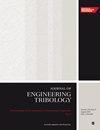An investigation on tribological properties of advanced microwave synthesized molybdenum disulfide as anti-friction additives in commercially available lubricating oils
IF 1.8
3区 工程技术
Q3 ENGINEERING, MECHANICAL
Proceedings of the Institution of Mechanical Engineers, Part J: Journal of Engineering Tribology
Pub Date : 2023-07-27
DOI:10.1177/13506501231189317
引用次数: 0
Abstract
The frictional stress between opposing contact surfaces will damage the mechanical parts of a machine. An appropriate lubricant can significantly reduce this. Blending nanoadditives with base oil is claimed to be an effective technique to increase the anti-friction qualities of lubricants using nanotechnology. Advanced microwave synthesized molybdenum disulfide (MoS2) anti-friction nanoadditive was employed in various lubricating oils namely fully synthetic, semi-synthetic, mineral, and hydraulic oil to formulate the nanolubricant. X-ray diffraction (XRD), field emission scanning electron microscope (FESEM), energy-dispersive X-ray spectroscopy (EDX), and a physical stability observation test were used to study the nanoadditives (MoS2) physicochemical characteristics. The tribological analysis of the MoS2 nanolubricant was measured using the four-ball tribotester. The coefficient of friction (COF) and average wear scar diameter (WSD) of the anti-friction additives were analyzed. The experimental results revealed improvements in COF and WSD in the range of 7.47–15.81% and 6.57–16.07% after the addition of MoS2 nanoparticles in the various lubricating oils. This study discovered that engine oil with advanced microwave-synthesized MoS2 nanoparticles has a significantly lower COF and WSD than engine oil that is not added with the anti-friction additives.先进微波合成二硫化钼作为市售润滑油减摩添加剂的摩擦学性能研究
相对接触面之间的摩擦应力会损坏机器的机械部件。适当的润滑剂可以显著减少这种情况。将纳米添加剂与基础油混合是一种利用纳米技术提高润滑油抗摩擦性能的有效方法。将先进的微波合成的二硫化钼(MoS2)纳米减摩添加剂应用于全合成、半合成、矿物油和液压油等多种润滑油中,制备纳米润滑剂。采用x射线衍射(XRD)、场发射扫描电镜(FESEM)、能量色散x射线能谱(EDX)和物理稳定性观察测试等方法研究了纳米添加剂(MoS2)的物理化学特性。采用四球摩擦学仪对二硫化钼纳米润滑剂进行了摩擦学分析。分析了减摩添加剂的摩擦系数(COF)和平均磨痕直径(WSD)。实验结果表明,在各种润滑油中加入纳米二硫化钼后,COF和WSD的改善幅度分别为7.47 ~ 15.81%和6.57 ~ 16.07%。研究发现,添加先进的微波合成二硫化钼纳米颗粒的发动机油的COF和WSD明显低于未添加减摩添加剂的发动机油。
本文章由计算机程序翻译,如有差异,请以英文原文为准。
求助全文
约1分钟内获得全文
求助全文
来源期刊

CiteScore
4.20
自引率
5.00%
发文量
110
审稿时长
6.1 months
期刊介绍:
The Journal of Engineering Tribology publishes high-quality, peer-reviewed papers from academia and industry worldwide on the engineering science associated with tribology and its applications.
"I am proud to say that I have been part of the tribology research community for almost 20 years. That community has always seemed to me to be highly active, progressive, and closely knit. The conferences are well attended and are characterised by a warmth and friendliness that transcends national boundaries. I see Part J as being an important part of that community, giving us an outlet to publish and promote our scholarly activities. I very much look forward to my term of office as editor of your Journal. I hope you will continue to submit papers, help out with reviewing, and most importantly to read and talk about the work you will find there." Professor Rob Dwyer-Joyce, Sheffield University, UK
This journal is a member of the Committee on Publication Ethics (COPE).
 求助内容:
求助内容: 应助结果提醒方式:
应助结果提醒方式:


